接入网的发展趋势.
有线电视接入网技术发展趋势

有线电视接入网技术发展趋势有线电视接入网技术是指利用有线电视网络实现宽带接入服务的技术。
近年来,随着互联网的迅猛发展,有线电视接入网技术也在不断进步,出现了一系列新的技术和发展趋势。
本文将从三个方面展开对有线电视接入网技术的发展趋势进行分析。
第一,光纤到户(Fiber to the Home,FTTH)技术的普及。
传统的有线电视接入网技术主要是基于同轴电缆或者铜线进行传输,带宽和速度有限。
而FTTH技术采用光纤作为传输介质,具有传输速度快、带宽大等优点,能够满足用户对宽带的需求。
随着光纤技术的成熟和成本的逐渐降低,越来越多的地区开始普及光纤到户技术,提供更快速、更稳定的网络服务。
第二,DOCSIS(Data Over Cable Service Interface Specification)技术的发展。
DOCSIS是用于有线电视接入网技术的一种标准协议,通过在同轴电缆上传输数据信号。
近年来,DOCSIS技术不断发展,推出了DOCSIS 3.0、DOCSIS 3.1等新版本,大幅提升了数据传输速度、信号质量和网络容量。
DOCSIS 3.1技术还支持全双工传输,即上行和下行信号可以同时传输,进一步提升了网络的性能。
第三,数字视频广播技术的应用。
数字视频广播技术是将传统的模拟电视信号转换为数字信号进行传输和接收的技术。
与传统的模拟电视信号相比,数字视频广播技术具有传输质量好、抗干扰能力强等优点。
数字视频广播技术的应用可以提供更加高清、稳定的视频信号,为用户提供更好的观看体验。
总之,有线电视接入网技术在面临互联网发展的挑战下不断创新和发展。
光纤到户、DOCSIS技术的发展以及数字视频广播技术的应用都是有线电视接入网技术的发展趋势。
未来,随着4K、8K视频、虚拟现实等新兴应用的普及,有线电视接入网技术还将继续创新,提供更快速、更稳定的宽带接入服务。
GPON光纤接入网络的发展趋势

用户 , 因此 在 人 口密度 比 较 高 的 城 市 , n 须 每 单 0L 板 支 持8 P 路 ON口甚 至 1 路 PON口 ( 常 为 1 个 槽 6 通 6 位 ) 这 样 每 路 G Oi下 行 有 2 3 有 效 带 宽 。 , P % I .G的 再 来看看 在F TTH场 景 下 的 网 络 建 设 为 什 么 需 要 超 大 分 光 比 。 F H网 络 建 设 中 , DN网络 占总 在 TT 0
本 特 质 就 是 要 容 量 非 常 大 , 盖 更 多 的 用 户 。 人 口 覆 以 比 较 密 集 的 城 市 为 例 , 平 方 公 里 大 概 是 10 用户 。 每 00
即 使 1 OL 个 T只 覆 盖  ̄ 5 ] 1km , 么 也 需 要 支 持 2 5 那 .万
线接人 为主 , 由于DS 技 术接人距离 的限制 , L 每个接
25 i s 对 称 的 X P NIH .Gbt 不 / G- O S 上下 行 对 称 1G i s 0 bt /
少居 所 ”的建 网 思 路 在 光 接 入 网 的 时 代 又 回 来 了, 但
光 接 入TC O点覆 盖 的 范 围 更 容 量 更 大 , 要 的 站 需 点数 更少, 至可 以减少站 点数量 的8 % 。 以 , 甚 0 所 针
网络投 资的5 -7 %。 人口密集的城 市, 0 0 在 规划一 个
O T机 房 需 要 覆 盖 几 万 甚 至 1万 F L 0 TTH用 户 , 要 从 需
的 XG— O 两 个 主 要 备 选 架 构 ; —P N2 1 受 P N2 NG O . 不  ̄ ] 现 有 的GP ON标 准 和 光 分 配 网络 限 制 , 全 新 光 网络 是
论接入网技术现状与发展趋势
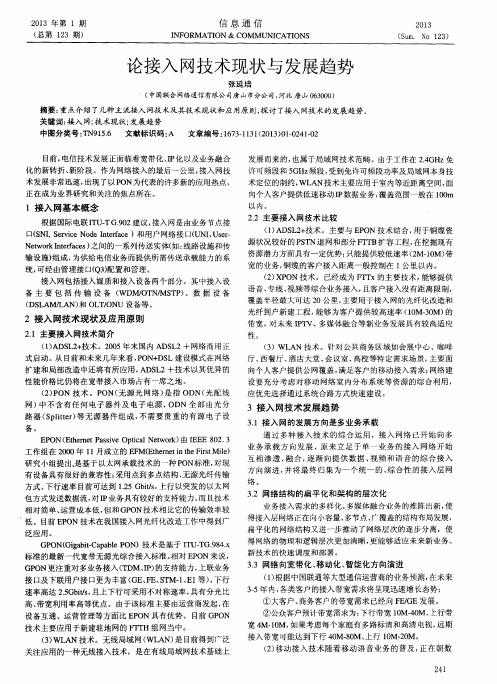
2 . 2 主 要接 入 网技 术 比较
( 1 ) ADS L 2 + 技术 。主要与 E P O N技术 结合 , 用于铜缆资 源状况较好 的P S T N退 网和 部分 F T T B扩容工程 , 在挖掘现有
低 。目前 E P O N技 术在我国接 入网光纤化 改造工作中得到广
泛应 用 。 G P O N( Gi g a b i t . Ca p a b l e P ON) 技 术 是 基于 I T U G. 9 8 4 . x
扩建和局部改造中还将有所应用 , ADS L 2+技术 以其优异的
光纤到户新建工程 , 能够为客户提供较高速率 ( 1 0 M一 3 0 M) 的
带宽 , 对未来 I P T V、 多媒体融合等新业 务发展具有较 高适应
性。
( 3 )WL A N技术 。针对 公共商务区域如会展中心、咖啡 厅、 西餐厅 、 酒店大堂、 会议 室、 高校等特定需求场景 , 主要面 向个人客户提供 公网覆盖 , 满足客户的移动接入需求 ; 网络建 设要充 分考虑对移 动网络室 内分布系统等 资源 的综 合利用 , 应优先选择通过系统合路方式快速 建设。
N e t w o r k I n t e f r a c e s ) 之 间的一系列传送 实体( 如: 线路设施和传 输设施) 组成, 为供给 电信业务而提供所需传送承载 能力 的系
统, 可经由管理接 口( Q3 ) 配置和 管理。
资源潜力方面具有一定优势; 只能提供较低速率 ( 2 M. 1 0 M) 带
浅谈综合业务接入网的发展趋势

元 的低 价 电脑 扶 贫 以 及 开放 健 康 的 市场 竞 争 环境 ; 二 是丰 富 的在 线应 用 和 内 容 , 第 教 育 与游 戏 相 结 合 形 成 的 应用 突 破 使 网 民的 上 网时 间从 每 月 l h提 高 到 4 h。 7 4 事 实 上 , 电 信 发 展 历 史看 , 从 当网 络 用 户 数 达 到 一 定规 模 时 , 种 应 用 会 自然 产 各 生 , 也 是 所 谓 的 迈 特 卡 夫 定 律 的威 力 所 这 在 。 历 史上 没 有 一 种 技 术生 来就 带 着 一大 堆 应 用 , 论 是 移动 通 信 还 是 互联 网 , 短 无 其 信 、浏 览 、 网上 聊 天 等 关键 应 用都 是 在 用 户 规 模 发 展 到 一 定 程 度后 自然 产 生 的 , 而 不 是 事 先 刻 意 设 计 和 策 划 出来 的 。 显 然 , 着 光 纤 在 长 途 网 、城 域 网乃 随 至 接 入 网 主 干 段 的 大 量 应 用 , 辑 的 发 展 逻 趋 势 将 是继 续 向接 入 网的 配 线 段和 引入 线 部 分 延 伸 , 键 是 推 进 速 度 有 多 快 。 这 将 关 取 决 于 多 种 因 素 , 括 市 场 的 需 求 、竞 争 包 的 需 要 、应 用 的 刺激 、技 术的 进 步 、 成 本 的 下 降 以 及 配套 运 维 系统 的开 发 , 等 。 等
每 隔 l ~2 年 就 会 有 新 的 技 术 和 系 统 诞 0 O 生 。然 而 这 种迅 速 更 新 和 变化 只发 生 在 电 信 网 的 核 心 , 长 途 网 和 中 继 网 部 分 。 而 即 电 信 网 的 边 缘 部 分 , 从 本 地 交 换 机 到 用 即 户之 间的 接 入 网一 直 是 电信 网领 域 中技 术 变化 最 慢 、 耗 资 最大 、成 本 最 敏感 、法 规 影 响 最 大 和 运 行 环 境 最 恶 劣 的 老 大 难 领 域。 然 而 近 年 来 , 互 联 网 为 代 表 的 新 技 以 术 革 命 正 在 深刻 地 改 变 传 统 的 电信 概 念 和 体 系结 构 , 着 各 国接 入 网 市场 的 逐 渐 开 随 放, 电信 管 制 政 策 的放 松 , 争 的 日益加 剧 竞 和 扩 大 , 业 务 需 求 的迅 速 出 现 , 线技 术 新 有 ( 包括 光 纤技 术 ) 无 线技 术 的 发展 , 和 接入 网 开 始成 为 人 们关 注 的 焦 点 。 在 巨大 的市 场 潜 力 驱 动 下 , 生 了各 种 各 样 的 接 入 网技 产 术。 接 入 网 的 出 现 , 整 个 电信 网 络 的 结 使 构 更 加 合 理 , 络 资 源 的 利 用 更 加 充 分 。 欲 ” 网 。 同时 随 着 高 速数 据 、高 质量 视 频 业 务等 宽 1. 3融合性 带 业 务 的 出 现 , 统 的 电 信 接 入 网 也 正 向 传 综 合 接 入 把 各 种 接 入 形 式 理 解 为 各 种 着数 字化 、综 合 化 、宽 带化 的方 向转变 , 因 不 同的 接 入 通 道 , 再 区 分 宽 带和 窄带 , 不 那 此接 入 网的 发展 目标 是 建 立 一 个综 合业 务 么 管理 的融 合 是 水 到 渠成 的必 然 要 求 。 网 接 入 网 , 正 在 接 入 层首 先 实 现 多 网的 融 络 建 设 和 维 护 体 制 也 将 逐 步 融 合 , 按 专 真 从 合 。 业 划分 转 变 为 按 网 络 层次 来 划 分 。这 种 融 合需 要 一 个 过程 , 融 合 的 方 向是 明确 的 。 但 只 有真 正 的做 到 “ 合 与 神 合兼 备 ” 才 是 形 , 1综合业务接入 网的内涵和外延 综 合接 入 不是 窄带 设 备 ( POTS、I DN 综 合 接 入 的 真 谛 。 S
铁路通信系统的接入网工艺及发展趋势

1 铁路 通信 某线 接入 网 ( 方框 图 )
该路线接入网结构框如 图1 。
约8 K欧一1K欧 ,挂机 阻抗约 1K .8 6 5 欧一2 K )。再加上外线距离 的 5欧 长短的变化 ,整个负 载阻抗变化很大 ,而普通音频 接 口的匹配阻抗为 60 0 欧姆 ,所 以阻抗匹配 的好环 ,直接关系到共线系统 的性能 。阻抗匹 配不好时 , 会产生较大的回波 ,势必造成通活话音量小 、音质差、容易 自 ( 激 振鸣 ) 等问题 。此外 , 共线电话对可靠性要求较高 ,为了保证铁 路运营 的安全 ,完成音频叠加不能集中在0I一 个点上 ,否则这个点 出 J 1 现故障则整个调度系统就会瘫痪。在F 1共线电话系统中,采用分级叠 A6 加方式 ,也称为数字共线 ,每个O U N 具有6 K 4 交叉能力 , 以可 以将音 所 频叠加分散到多d O U " N 上完成 ,同时 ,F 商丕 A 提供对共线电话 的保护。 22 闭 塞 电 话 /热 线 电 活 _ 闭塞电话也叫站间行车电话 ,是铁路调度系统 中仅此 于共线电话的第 二大业务.主要完成相邻站之间的点到点通信。传统的方式一般上行站和 下行站 的集中机之间采用共总盘一共分盘或磁石盘一磁石盘实 回 线通信方 式 , 以前者为主, 并 、 共总盘能产生铃流,共分盘有铃流检测电路和振铃电 路, 共总盘和共分盘需要成对使用 。共总盘呼叫其分盘时 , 把共总盘扳键
上扳 , 振出交变振铃信号至共分盘 ,共分盘检测到铃流后 , 启动 自 己的响 铃电路 ,并向共总盘送回铃音。随班员听到铃响 , 摘机通活,同时共总盘
检测到环路电流后停止送铃流。共分盘呼叫共总盘时 ,将扳键上扳 ,接通 ; 本方通话电路 :对共总盘而言 ,构成外线的直流通路 ,共总盘检测到环路 J ●‘ 电流 ,启动响铃电路,值班员听到铃响,摘机通话。
宽带光纤接入网的发展趋势(计算机专业英文翻译)

Wide band optical fiber access network trend of developmentThis article first is brief introduced the world broadband access network develops the condition and the main application, next narrated the wide band optical fiber access network merit. With emphasis has once more analyzed the wide band point-to-point active Ethernet optical fiber system and the wide band to the passive optical fiber system characteristic and the application. Meets down proposed our country optical fiber access network sends chem. possible to surmount APON, BPON and the EPON stage, starts from the wide band point-to-point Ethernet optical fiber system and GEPON, finally and even transits to the GPON stage preliminary idea. Finally analyzed the optical fiber communications technology trend of development from each angle.The broadband access network develops condition and main applicationIn fact, looking from the telecommunication development history, when the network number of users achieves certain scale. Each kind of application meets the nature production; this also is so-called steps the Cuff law might to be at especially.In the history one kind of technology since birth has not been having a big pile of application, regardless of is the mobile communication or the Internet, on its short note, the browsing, the net chats and so on the key applications all is develops certain degree after the user scale to produce naturally, but is not sedulously designs beforehand plans.Since has entered for the 21st century, the whole world broadband access network entered the big development phase. To 2004 year's end, the total number of users already achieved 150,000,000, became in the electricity reliable historical account to develop one of quickest telecommunication services, and even was also quicker than the mobile service. For example the whole world mobile service from 10,000,000 developed to 100,000,000 has spent for 5.5 years, but the broadband access service has only used for 3.5 years.According to the IDC forecast, in 2007 the global wide band total user may achieve 209,000,000, in which 9.9, namely about 20,000,000 users for optical fiber access network.The Asian and Pacific area, specially South Korea's and Japan were the broadband access develop the swiftest most and violent country, the South Korean wide band user total already break through 10,000,000, the wide band popular rate occupied the world first, hold family 7 Internet 90%.Japanese Government also vigorously advances the wide band development through each measure, plans in 2005 to enhance the wide band user total to 30,000,000, in which FTTH achieves 1 10, still is the world biggest broadband access market, the total number of users surpasses 30,000,000.American FOC the wide band service localization is one of 2003-2008 year six big goals, in fact the broadband access is becoming the American universal service the next goal. The US broadband access is primarily develops by the cable television and ADSL, because the telecommunication control policy encouragement uses the new technical construction network (e.g. FCC stipulation operation business construction optical fiber access network to be possible not limited the pressure which in local ring circuit non-colligation policy) as well as the competition and the service grows, recently leads the operation business to be extremely positive to the optical fiber to the station (FTTP) development.Speaking of the optical fiber access network, specially the optical fiber to station(FTTP) or optical fiber proficient (FTTH), the whole world already started to enter the unloading phase, only US had 270 FTTP projects, was mostly the local authority, the public company, the property developer and the non-leading telecommunication operation business project. Leading operation business also starts to enter this domain, in which Version plans in 2005 to complete 3,000,000 FTTP; SBC in the plan plans in 2007 in its huge “speed of light” to reach 18,000,000 FTTN, each household has speed 20-39Mb/s, provides the end-to-end tertiary service colligation (trite play) the service. Japan is in the world advances the FTTH most radical country, 2.004 years its optical fiber on already understood more than 18,000,000 households families, but the user development lag, probably was 2,000,000, in 2005 plans develops 10,000,000.Europe quite is steady conservatively, FTTH altogether has laid to 2004 500,000, some 167 small projects or the experimental project are carrying on.Our country broadband access network extremely is also rapid in the near two year development, according to the preliminary statistics, to 2004 year's end our country wide band user is 25,000,000, becomes is inferior to US's second big broadband access market, in which leadership technology is only ADSL, probably accounts for about 70%, next is the Ethernet technology, but also has few wide band wireless turning on and electric cable modem turning on, also occupies regarding the FTTH technology the track stage, the minority developed city already was also starting to consider and to experiment each kind of FTTHI technology.Looking from the wide band application that, according to the American Mai Kenxi Company's newest analysis, the initial period wide band application mainly is the high speed surfer, may make the surfer the time to increase approximately 30%.Hereafter, along with the service large-scale development, develops the power which the new service becomes continues to develop. According to American BHK Corporation demonstrated in 2004 investigation result that, in 2003 the American first five wide band expense was on the net gambles, the adult program, the game, music downloading and the selection and broadcast television, had obviously to the expense class incline tendency.Needs to point out that, discusses needs to pay attention to in a basic understanding using the actuation the erroneous zone, namely cannot place hopes in artificially studies beforehand develops 12 items so-called “the Assassin's mace application”, promoted application. In fact, looking from the telecommunication development history, when the network number of users achieved certain scale, each kind of application meets the nature production; this also is so-called steps the Cuff law might to be at especially. In the history one kind of technology since birth has not been having a big pile of application, regardless of is the mobile communication or the Internet, on its short note, the browsing, the net chats and so on the key applications all is develops certain degree after the user scale to produce naturally, but is not sedulously designs beforehand plans.Wide band optical fiber access network superiorityAlong with the optical fiber in the toll network, the metropolitan area network and even the access network branch section massive applications, the logical trend of development will be continues to the access network to match the line segment and to direct the inlet part to extend, the key is advances the speed quickly? This will be decided by many kindsof factors, including the market demand, the competition need, the application stimulation, the technical progress, the cost drop and necessary will transport Augur system development and so on. Our country in 2008 will hold the Olympic Games and in 2010 holds world expo these two big events to a certain extent to be able to advance the wide band optical fiber access network the developmentBelow mainly will analyze several kind of main wide band optical fiber turning on technology from the system technology angle the characteristic, the question and the trend of development. Certainly, besides the system technology, affects its application the factor to be very many, mainly is the service and the application as well as the control policy. In addition, each kind of necessary primary device technology and the placing installment test technology extremely is also essential. At present the low cost photo source hopefully has realized, 850nm VCSEL only several US dollars, 1310nm VOSEL had the breakthrough, the speed reaches 10Gb/s.The PLC mix integration technology, the high density low cost optical cable and the correlation technology, uses the optical fiber to the curving insensitive room in, the low cost passive component, work the technology, the automatic light operation test system and so on also all is affects the light access network promotion application the key aspect, needs to have the properly solution.The point-to-point active EthernetBecause system the cost, the quality, the management, the security and so on many kinds of factors, the Ethernet still had further to improve as the public network turning on way.The traditional Ethernet belongs to the user in network (cPN).However its application actually in to include the access network other public network domain expansion. In the history, regarding business user application environment, the Ethernet technology always is the most popular method, at present has become only definitely in the power supply receptacle second big housing and the office public facility connection. Uses the Ethernet is had the huge network foundation and the long-term experience knowledge, at present all popular operating system and the application as the business user turning on method primary cause also all is with the Ethernet compatible, the performance price compared to good, the extendibility, easy to install the clear as well as redundant reliable and so on.Regarding the public network housing user application environment, the point-to-point active Ethernet system uses the active service focus point to substitute the passive point-multipoint system the passive component, enables the transmitting range to be possible to expand to 1 20 kilometer far. The main merit is special-purpose turning on, the band width has the guarantee, each user may monopolize 100Mb/s and even 1dbs; Bureau end equipment simple cheap; The transmitting range is long, the service area is big; But the cost the linearity increases along with the number of users actual growth, does not need to plan, the investment risk is low, thus disperses the local cost in the low density user to be low. The shortcoming is the both sides equipment and the optical fiber facility special-purpose, the user cannot share the bureau end equipment and the optical fiber, when the demand fast growth also the user are very crowded, optical fiber and both sides equipment quantity and cost as well as spatial demand also along with it rapid increase, thus not too suits the high crowded user region. The influence choice Ethernet technology another factor is the traditional video frequency service provides the way, forexample American Place Bell Company all pledged provides the tradition to simulate the RF video frequency program, but the Ethernet and the simulated video program mix is very difficult. This aspect PON technology quite is easy.Because the cost, the quality, the management, the security and so on many kinds of factors, the Ethernet still had further to improve as the public network turning on way. Mainly is the Ethernet technology inherent mechanism does not provide the end-to-end package time delay, the package loss rate, the band width control, supports the real-time service with difficulty the grade of service, lacks the safety mechanism guarantee and so on.Point-multipoint passive, light network systemAlong with IP rising with the development, some people proposed the EPON concept, this thought obtained the positive response in the Ethernet, has already formed the GEPON standard in under the IEEE 802.3ah flag.1. Passive light networkingPassive light network (PoN) is one pure medium network, its main characteristic has removed the active equipment in the access network, thus has avoided the electromagnetic interference and the thunder and lightning influence, reduced line and the external instrumentation failure rate, reduced correspondingly has transported the Augur cost. Next, the PON service transparency is good, the band width is wide, suitably in any service pattern and the speed signal, can support the simulation broadcast television service quite economically, has tertiary service function (triple-play).Finally, as a result of its game of end equipment and optical fiber by user sharing, thus the line cost compares other point-to-point mailing address to have to be low, the construction cost also may reduce obviously. Especially day by day advances along with the optical fiber to the user, its synthesis superiority is more and more obvious. But the PON each user cost along with shares OLT the user quantity increase to drop rapidly, thus most suits in the dispersible small business and the inhabitant user, these user region is specially dispersible, but each region user relative centralism small area crowded user area, in particular newly built region. Finally, after considered uses the PON technology quite to be easy to continue to provide traditional the simulated video program, thus, most American Place Bell Company favors the PON technology, but is not the light Ethernet technology.The PON main shortcoming is the disposable investment cost is high, because bureau end light line terminal OLT is very expensive, the optical fiber and the shunt and so on the passive infrastructure must an arriving, when like this the number of users are few or the user distribution surpasses some definition is away from, each user's cost is very high. Moreover, its tree branch topology caused the user not to have the protection function or the protection function cost is high, has affected the large-scale development.2. APON AND BPONThe early narrow band passive light network is based on TDM, the performance price compared not well, already naturally withers away. An ATM passive light network (APON/BPON) may use ATM the centralism and the statistics multiplying, the recombination passive shunt to the optical fiber and the light line terminal sharing function, enable the performance price compared to have the important improvement, at present in countries and so on US and Japan already started commercial.However, the actual APON/BPON service adaptive provides at present very complex,provision of service ability is limited, the data transmission rate and the efficiency are not high, the cost is high, but its market prospect as a result of ATM decline dim. Finally, looking from the long-term service trend of development that, the APON available band width was still insufficient. Take FTTC as the example, although the typical branch downward speed may reach 622Mb/s, after but because the by-pass, actual as separable greatly will reduce as each user's band width. According to 32 groups’ computations, each branch available band width only remains 19.SMb/s, again presses 10 user sharing, then each user only can obtain approximately the 2Mb/s band width. Obviously, such performance price compared to is unable to satisfy the network and the service long-term development needs.3. EPON/GEPONAlong with IP rising with the development, some people proposed the EPON concept, namely in with APON and the BPON similar structure and in the O.983 foundation, tries to retain its essence part - physics level PON; But replaces ATM by the Ethernet to take the link level agreement, constitutes one to be possible to provide a greater band width, theLow cost and wider professional ability new marriage - EPON. This thought obtained the positive response in the Ethernet; in IEEE802.Under the 3ah flag has already formed the GEPON standard. In reality, EPON and the GEPON basic difference is the standardization, the former oftenRefers to the non-sign equipment, the latter refers conforms to IEEE 802.3ah, standard equipment. Moreover, the GEPON transmitting range and the by-pass compare have compared to EPON reduce.EPON/GEPON and the traditional point-to-point Ethernet main different place lies in the work in the point-multipoint mailing address. Its downward direction work in the TDM way, the data stream changes the longEther frame way to broadcast ONU, each ONU basis ether frame MAC address, decision choices. The upward direction work in the TDMA way, Comes from the different time slot ONU data stream to gather the public optical fiber facility and OLT. In addition, the traditional Ethernet work in the continual optical transmission pattern, is receiving and dispatching two directions both is the continual bit class, therefore receives the end fixed time easily to realize with the decision. But the EPON/GEPOkI ONUpward bit class is the sharp-edged data packet which transmits in turn, the OLT receive timing recovery, the decision threshold establishment, the range finder and the time delay compensation quite is complex.Looked from the EPON/GEPON structure that, its essential meritEnormously simplified the traditional multi-layered overlapping network Structure, the main characteristic included:- - Eliminated ATM and the SDH level, thus reduced the initial cost and the movement cost;- - The downward service speed reaches as high as 1Gb/s, the permission support multi-user, each user's band width may be higher, and can provide video frequency professional ability and good QOS- - The hardware is simple, does not need outdoor electronic installation, and enables the installment deployment work to simplify;- - May use the Ethernet technology mature chip massively, the realization is simple, the cost low- - improved the electric circuit to refer to the coordination service nimbly provision with the reshuffle ability.IEEE 802.3ah the standard GEPON technology standards is good, on the downward wave length is 1310 and 1490nm, on the downward speed is 1.25Gb/s, the transmitting range is 10/20km, the by-pass compared to is 16, the primary service is the data and the sound of talking,after increases a 1550nm visual broadcast wave length, becomes the sound of talking, the data and the television method of three-in-one “triple-play” the wide band service colligation service, but this will be the future family service “the Assassin's mace application”.The EPON/GEPON main shortcoming is the efficiency low and supports outside the Ethernet with difficulty the service. The former is because uses 8B/10B the line code, introduces 20% band width loss, in addition other expenses, available load only about 50%, but APON and GPONall use NRZ to harass the code are the line codes, does not have the band width loss.In addition reasons and so on load bearing plate efficiency, transmission gathering plate efficiency, service adaptive efficiency, cause the EPON/GEPON total transmission efficiency to be very low, probably only is GPON half.4. GPONIn 2001, formulated EPON standard positively while IEEE, the FSAN organization starts to initiate the formulation speed to surpass 1Gb/s PON network standard 1,000,000,000,000,000 Ethernet passive light network (GPON), afterwards, ITU-T also involved this new standard formulation work and 1 Dan (speed enhances in 2003 throughtwo related GPON new standard G.984.1 and G.984.2 to 2.5Gb/s). According to this newest standard stipulation, GPON may provide 1.244 and the 2.488Gb/s downward speed and the all standard upward speed; The transmitting range amounts to 20 kilometers at least, has the high speed highly effective transmission characteristic. Moreover, GPON has selected two seal methods, besides traditional ATM, but also has used one brand-new in the transmission gathering level based on sDH standard general group frame procedure GFP, this is one kind may transparently highly effective Seals the existing SDH network each kind of data signal the general standard signal adaptive mapping technology, may adapt any subscriber signal form and any transmission network service pattern, namely may according to the inherent form transmission pronunciation, the data and the video signal, does not need to attach ATM or the P seal level, has manifested the service provider comprehensively to the provision of service nimble request, but APON/BPON and EPON/GEPON all need to provide the specific adaptive method to each kind of specific service. Because uses the GFP mapping, the GPON transmission gathering level essentially is a synchronization, enables GPON to be possible to support end-to-end fixed time and other orbit service, specially may the direct high quality support the TDM service nimbly.From the technical angle, GPON is the BPON inheritance and the development, GPON has inherited BPON very many essential features, for example both all use the same OLT nucleus, the heart technology, and uses the similar physical optical fiber facility and the luminous power budget and so on. On the other hand, GPON has used some newest technology achievement, besides most important GFP seal, but also includes the forward-acting error correction and so on the new technology.From the service which provides looked, not only GPON may provide 10/100Mb/s,1Gb/s the service, moreover may provide the VLAN service and the pronunciation service, in fact might adapt any view to have the service and the future new service adaptive request. Total looking at, GPON is not the manufacturer actuation technical standard, but is one kind of operation business actuation standard, therefore has the thoroughbred operation benefit to consider, the speed is higher, may reach 2.4Gb/s; Has the general mapping form, may adapt any new old service; Has the rich OAM&P function; Has the very high transmission efficiency to each kind of service, even if regarding the TDM service also can the nimble highly effective low expenses transmission. May help the operation business to complete from the traditional TDM pronunciation electric circuit to the entire IP network smooth transition, its shortcoming is still retains has the complex ATM level function, the cost is high.Because three kind of PON capital expenditures (70% all are approximately) the light connections, thus its hardware cost should differ not much, but because in the realization technology difference, the GEPON difficulty is at present smallest, the cost is lowest. But speaking of the transmission efficiency, then GPON regardless of is harassing the code efficiency, the transmission gathering plate efficiency, the load bearing agreement efficiency and the service adaptive efficiency aspect all is highest, therefore its overall effectiveness index is highest. For example the supposition TDM service accounts for 10%, but the data service accounts for 90%, then the GPON overall effectiveness index is 94%, but APON and GEPON respectively are 72% and 49%.GPON and EPON/GEPON face the together challenge includes: How can have nine load bearing TDM service on Ethemet/GFP and can provide the telecommunication level the grade of service; Next, because GPON and EPON/GEPON are select to the multi-spot star type or the shape of tree network, will need 1+1 and passes through the different route light network through one to realize the telecommunication level protection to restore the request, the network cost extremely is high; Third, at present GPON and the EPON/GEPON equipment cost main limited in arises suddenly the light transmission/receive module as well as the nucleus, the heart control module/chip. These modules either are the technology are unable not maturely commercial, either is the price expensive also with difficulty meets the market requirement; Fourth, GPON and the EPON/GEPON disposable investment cost is high, not too suits invests the militancy gradually the traditional telecommunication construction pattern, most suits completely newly built or the reconstruction crowded user region.Recently some people to optical fiber communications development scene, somewhat puzzled. First, in 2000 the IT profession froth, caused the optical fiber communications the scale of production investment oversized, the overproduction, in the IT profession many small companies went out of business. Specially the optical fiber, overseas dumps to China. Second, some people thought that, Optical fiber communications through-put capacity already achieved 10Tbps, could not use up nearly, moreover the present main trunk line already constructed almost, buried the place the surplus optical fiber very to be also many, optical fiber communications technology not need more development.The author will believe that, optical fiber communications technology still have the very big development space, will be able to have the very big demand and the market from now on. Mainly is: The optical fiber to family FTTH, the light exchange and the integrated photoelectron component aspect can have the big development. Mainly discusses the optical fiber communications in this the trend of development and the market..Generally speaking, the optical fiber access network has represented the broadband access network long-term development direction, each kind of wide band optical fiber access network all has its best use situation and the opportunity, the wide band point-to-point active Ethernet optical fiber system suits in the low density user dispersible area application, the wide band point-multipoint passive optical fiber system most suits newly built or the reconstruction crowded user area should. Our country's trend of development possibly will surmount APON, BPON and the EPON stage, will start from the wide band point-to-point Ethernet optical fiber system and GEPON, and even will transit quickly to the GPON stage.宽带光纤接入网的发展趋势本文首先简要介绍世界宽带接入网发展的状况和主要应用;其次讲述了宽带光纤接入网的优点;再次重点分析了宽带点到点有源以太网光纤系统和宽带点到多无源光纤系统的特点和应用。
计算机网络之接入网技术

计算机网络之接入网技术在当今信息技术高速发展的时代,计算机网络的快速发展已经成为现代社会的一种必然趋势。
而作为计算机网络的基础设施之一,接入网技术在实现计算机网络广泛连接的过程中起到了重要作用。
本文将就接入网技术进行讨论,主要内容包括接入网技术的概念、发展历程、主要类型以及未来趋势。
一、接入网技术的概念接入网技术是指将终端用户连接到广域网或互联网的网络技术。
它是计算机网络的入口,为用户提供与互联网交互的通道。
接入网技术的发展与用户对高速、稳定、安全的网络连接需求密切相关。
二、接入网技术的发展历程接入网技术的发展经历了几个重要阶段。
早期的拨号上网技术是用户通过电话线路连接到ISP(互联网服务提供商)的方式,其速度较慢、连接不稳定。
后来,随着宽带接入技术的发展,如ADSL、光纤等,用户可以享受到更快速、稳定的网络连接。
目前,随着5G技术的应用,无线接入网技术也得到了快速的发展。
三、接入网技术的主要类型1. 宽带接入技术宽带接入技术是指使用宽带传输介质,如光纤、同轴电缆等,提供高速网络接入服务。
其中,光纤接入技术由于其较高的传输带宽和抗干扰能力得到了广泛应用。
2. 无线接入技术无线接入技术是指利用无线信号将用户连接到网络的方式。
其中,Wi-Fi是最常见的无线接入技术之一,用户可以通过无线路由器接入网络。
此外,蜂窝网络、卫星网络等也是常用的无线接入技术。
3. 其他接入技术除了宽带和无线接入技术,还存在一些其他接入技术。
例如,以太网接入技术是使用以太网协议实现用户接入的方式,具有成本低、易于扩展等优点。
另外,光纤到户(FTTH)接入技术也是一种高速接入技术。
四、接入网技术的未来趋势随着计算机网络的快速发展,接入网技术也将迎来新的挑战和机遇。
未来,接入网技术将朝着更高速、更稳定、更安全、更智能化的方向发展。
例如,随着5G技术的商用,无线接入网将进一步提速,用户可以享受到更低的延迟和更高的带宽。
此外,随着物联网技术的普及,接入网技术也需要支持更多设备的连接和数据传输。
浅析宽带接入技术及其发展趋势

浅析宽带接入技术及其发展趋势由于网络基础设施建设的投资重点就是接入网的建设,且其所占比例在总投资中相当大,可以说宽带接入技术的发展是网络建设的关键。
所以本文主要研究宽带技术的现状及其分类,通过这些研究总结未来宽带技术的发展趋势。
标签:接入技术,宽带,发展,趋势宽带业务以每年几倍的速度不断递增,可见越来越多的人使用网络,人们已经与整个网络密不可分了。
但是随着宽带业务的兴起,虽然它的服务量越来越大,但是其传播速度却无法与它的服务量成正比,这就远远无法满足宽带用户的需求。
因此,宽带接入网如今面临着非常严峻的考验。
接入网面临的最严重的三个考验分别为:1)工程量繁琐复杂且十分庞大;2)高昂的资金投入;3)技术维护难度巨大。
要想解决这些问题,就要求我们必须了解宽带技术和其未来的发展趋势。
一、宽带接入技术的分类宽带技术的有效应用有利于网络技术的不断发展,还可以帮助用户获得所需要的信息,信息资源的网络化也得以很好的实现。
现阶段的宽带接入技术主要分为以下几种:1)局域网络接入技术;2)xDSL 接入技术;3)HFC接入技术;4)无线接入技术;5)光纤接入技术等。
1、局域网接入技术以太网技术是我国局域网接入技术中最为普遍使用的一种技术。
拥有这种技术的局域网基本采用的都是以太网协议。
从1998年开始,以太网技术开始成为我国公用网络普遍使用的技术,且深受用户欢迎,这促使以太网技术快速在我国发展并达到最广泛的网络覆盖面。
以太网技术得以在我国广泛应用主要有三点原因:1)传输力强。
以太网技术的最大优势就是传输力强,其接入能力可以达到每秒10Mbit到100Mbit。
其他宽带技术很难与之相匹敌,虽然ATM-PON 接入技术的接入能力与以太网相类似,但是因为网络出口与用户需求方面的不同,接入速度都会受到影响,使接入速度逐渐降低。
2)以太网协议成熟且稳定。
因为以太网技术已经发展成熟,所以协议很简单,促使以太网也具有极高的稳定性,这样使设备的兼容性得到保证,可以很好的兼容由不同厂家生产的不同设备。
光纤接入网技术现状及发展趋势
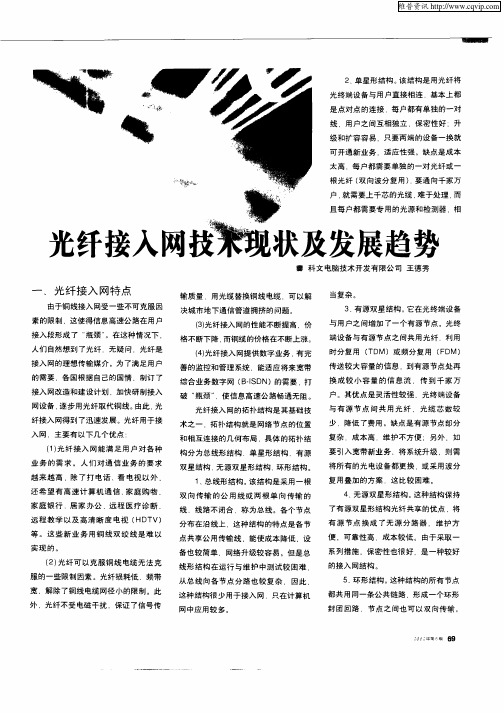
太 高 。每户 都需要单独 的一对光纤或 一
根 光纤 ( 向波分 复用 ) 要通 向千家万 双 . 户 。 需要上千芯 的光缆 。 于处理 , 就 难 而
且 每户都需要 专用的光源 和检测器 。相
发展趋势
褥 科文 电脑 技术 开发有 限公司 王德 秀
一
、
光纤 接入 网特点
由于铜线接入 网受一些不可克服 因
网中应 用较 多。
: 0 6 e9 0: 目
维普资讯
其 优 点 是 提 高 了 线 路 设 定 的 自 由度 和 灵
一
光 线路终端 ( T OL )变成光信号 .经
三 、光 纤 接 入 技 术
传 送 网与 接 入 网 虽然 有 紧 密 的 联
素的限制 。 使得信息 高速 公路在用 户 这
接 入段形成 了 “ 瓶颈 ” 。在这种情 况下 。 人 们 自然想到 了光纤 .无疑 问 。光纤是 接入 网的理想传输媒 介 。为 了满足用户 的需要 。各 国根据 自己的国情 。制订 了
接 入 网 改 造 和 建 设 计 划 。加 快 研 制 接 入
和 相互连接 的几何布局 , 体 的拓 扑结 具
构 分为总线形结 构 .单星形结 构 、有源
双 星结构 、 源双星形结 构 、 形结构 。 无 环
将所 有的光 电设备都更换 。或采用 波分
复 用叠加的方案 .这 比较 困难 。 4 无源双星形结 构。 种结构保持 、 这 了有源 双星形结构 光纤共享 的优 点 。将 有 源 节点 换 成 了无 源 分路 器 。维护 方
系, 但是 其性质完全不 同 。 在传 送 网中 , 用 于市 内电信局 之间的本地 中继 网与国 家 干线网和省 内干 线网在某些方面性 质 相似 。本地 中继 网主要位于城 市 ,受国
有线电视接入网技术发展趋势
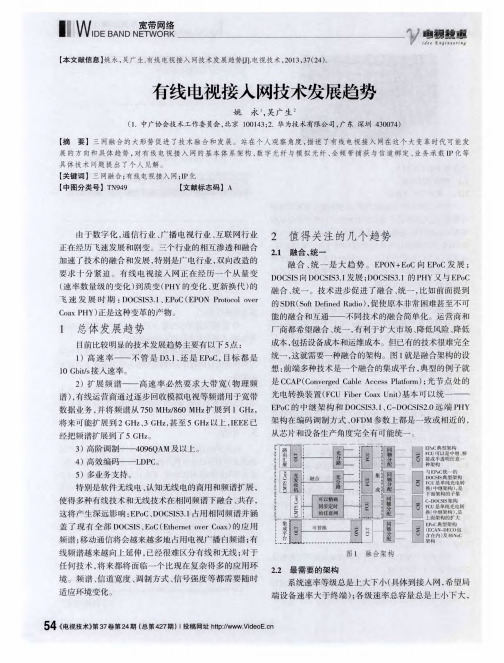
( 上接第 5 1 页) 对 比改 进前后 的 S S L 协 议握手 时 的测试 结果 , 统计对 比
图表示如 图 8 所示 。
1 . 4 1 . 3
1 2 1 1
参考文献 :
[ 1 ] 卡哈特 . 密码学 与网络安全【 M】 . 2 版. 北京 : 清华大学 出版社 , 2 0 0 9 . 【 2 】 沈承 东 , 郑海源 . S S L协 议 的安全性 及其 分析Ⅲ. 电脑知识 与技 术,
2 0 1 2 ( 4 ) : 2 7 2 6 — 2 7 2 8 .
厘
1 . 0
0. 9
0 8 0 7
[ 3 ] 丁霞军 , 蒋 晓丹 , 韩 双霞 , 等. 基于S S L 协议 与 S E T 协议的 电子 商务 支付安全研究 [ J J . 科技信息 , 2 0 1 0 ( 2 8 ) : 1 8 — 1 9 .
很 容易 实现 分前 端到 每个用 户家庭 1 - 2 根光纤 。届 时 ,
家 庭 网络设备 可 以全 部采用 新型 能源 , 供 电也不会 成为 问题 。也 许 , 把 光纤从 分前端 拉到 用户家 中才是最 终 的
解决方 案 。
f e a t u r e s / f u l lb a n dc a p t u r e . p h p.
的 电话 双绞线— —现 在光纤 造价 已经低 于双绞线 ; 最 大 参考文献 :
】 】 博通 官 网 [ E WO L J . / 2 0 1 3 - 0 9 一 O l 1 . h t t p z / J w w w . b r o a d c o m . c o n r / p r o d u c t s / 光缆 芯数也达到 了3 4 5 6 芯; 像 中国这 样的密集居住环境 [
接入网技术现状与发展趋势
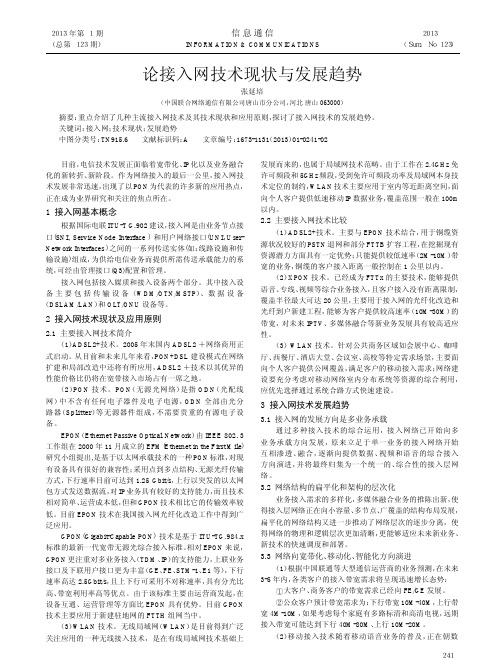
论接入网技术现状与发展趋势张延培(中国联合网络通信有限公司唐山市分公司,河北唐山063000)摘要:重点介绍了几种主流接入网技术及其技术现状和应用原则,探讨了接入网技术的发展趋势。
关键词:接入网;技术现状;发展趋势中图分类号:TN915.6文献标识码:A文章编号:1673-1131(2013)01-0241-02目前,电信技术发展正面临着宽带化、IP化以及业务融合化的新转折、新阶段。
作为网络接入的最后一公里,接入网技术发展非常迅速,出现了以PON为代表的许多新的应用热点,正在成为业界研究和关注的焦点所在。
1接入网基本概念根据国际电联ITU-T G.902建议,接入网是由业务节点接口(SNI,Service Node Interface)和用户网络接口(UNI,User-Network Interfaces)之间的一系列传送实体(如:线路设施和传输设施)组成,为供给电信业务而提供所需传送承载能力的系统,可经由管理接口(Q3)配置和管理。
接入网包括接入媒质和接入设备两个部分。
其中接入设备主要包括传输设备(WDM/OTN/MSTP)、数据设备(DSLAM/LAN)和OLT/ONU设备等。
2接入网技术现状及应用原则2.1主要接入网技术简介(1)ADSL2+技术。
2005年末国内ADSL2+网络商用正式启动。
从目前和未来几年来看,PON+DSL建设模式在网络扩建和局部改造中还将有所应用,ADSL2+技术以其优异的性能价格比仍将在宽带接入市场占有一席之地。
(2)PON技术。
PON(无源光网络)是指ODN(光配线网)中不含有任何电子器件及电子电源,ODN全部由光分路器(Splitter)等无源器件组成,不需要贵重的有源电子设备。
EPON(Ethernet Passive Optical Network)由IEEE802.3工作组在2000年11月成立的EFM(Ethernet in the First Mile)研究小组提出,是基于以太网承载技术的一种PON标准,对现有设备具有很好的兼容性;采用点到多点结构、无源光纤传输方式,下行速率目前可达到1.25Gbit/s,上行以突发的以太网包方式发送数据流,对IP业务具有较好的支持能力,而且技术相对简单、运营成本低,但和GPON技术相比它的传输效率较低。
宽带网络接入技术的发展、现状、成果、趋势分析-共19页

宽带网络接入技术的发展、现状、成果、趋势1、接入技术的发展现状电信网发展到今天,正在进入一个新的转折点,展现了宽带化、IP 化以及业务融合化的趋势。
电信网宽带化首当其冲的就是接入网的宽带化,然而由于种种原因,接入网的宽带化将是电信网宽带化最难实现的部分。
接入网可由三个接口界定,即网络侧经由SNI与业务节点相连,用户侧由UNI与用户相连,管理方面则经Q接口与电信管理网(TMN)相连。
接入网的引入给通信网带来新的变革,使整个通信网络结构发生了根本的变化。
接入网的重要特征可以归纳为如下几点:(1)接入网对于所接入的业务提供承载能力,实现业务的透明传送。
(2)接入网对用户信令是透明的,除了一些用户信令格式转换外,信令和业务处理的功能依然在业务节点中。
(3)接入网的引入不应限制现有的各种接入类型和业务,接入网应通过有限的标准化的接口与业务节点相连。
(4)接入网有独立于业务节点的网络管理系统,该系统通过标准化的接口连接TMN,TMN实施对接入网的操作、维护和管理。
传统的用户接入同采用的是钢缆,80年代中后期因具有Z接口的光纤环路载波系统(SLC)以及远端交换模RSU的实用化,使光纤传输设备引入到接入网领域,但这些都不是真正意义上的接入网设备。
到90年代中期,先进的VS接口光接入系统问世,才进入接入网的正式发展阶段。
VS接口可实现不同厂家接入网设备与交换机的互通,接入网具有较强的业务支持能力,除支持PSTN、ISDN业务外,还支持N X 64kb /S、64kb/S以下各类速率、Internet、X.25、CATV等业务。
到2019年8月初,全国建设规模已近270万线,超过世界其它国家。
此外电信部门还积极推进公众多媒体通信接入系统,并正在试验先进的ATM接入和VOD系统。
1.1有线接入技术有线接入技术包括:基于双绞线的ADSL技术、基于HFC网(光纤和同轴电缆混合网)的Cable Modem技术、基于五类线的以太网接入技术以及光纤接入技术。
接入网发展和趋势
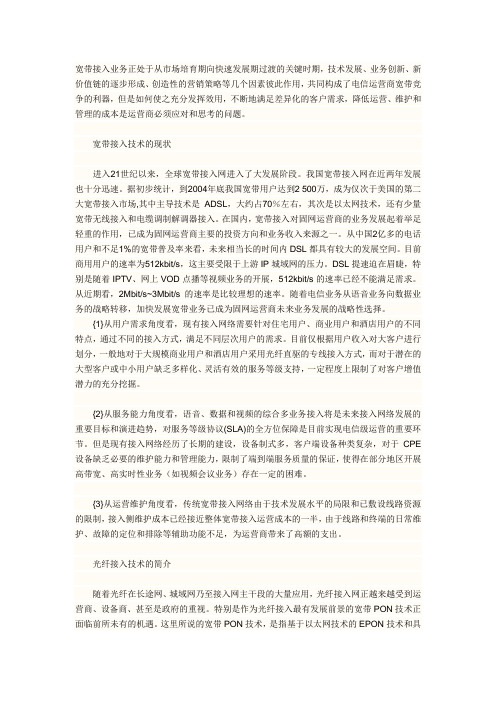
宽带接入业务正处于从市场培育期向快速发展期过渡的关键时期,技术发展、业务创新、新价值链的逐步形成、创造性的营销策略等几个因素彼此作用,共同构成了电信运营商宽带竞争的利器,但是如何使之充分发挥效用,不断地满足差异化的客户需求,降低运营、维护和管理的成本是运营商必须应对和思考的问题。
宽带接入技术的现状进入21世纪以来,全球宽带接入网进入了大发展阶段。
我国宽带接入网在近两年发展也十分迅速。
据初步统计,到2004年底我国宽带用户达到2 500万,成为仅次于美国的第二大宽带接入市场,其中主导技术是ADSL,大约占70%左右,其次是以太网技术,还有少量宽带无线接入和电缆调制解调器接入。
在国内,宽带接入对固网运营商的业务发展起着举足轻重的作用,已成为固网运营商主要的投资方向和业务收入来源之一。
从中国2亿多的电话用户和不足1%的宽带普及率来看,未来相当长的时间内DSL都具有较大的发展空间。
目前商用用户的速率为512kbit/s,这主要受限于上游IP城域网的压力。
DSL提速迫在眉睫,特别是随着IPTV、网上VOD点播等视频业务的开展,512kbit/s的速率已经不能满足需求。
从近期看,2Mbit/s~3Mbit/s的速率是比较理想的速率。
随着电信业务从语音业务向数据业务的战略转移,加快发展宽带业务已成为固网运营商未来业务发展的战略性选择。
{1}从用户需求角度看,现有接入网络需要针对住宅用户、商业用户和酒店用户的不同特点,通过不同的接入方式,满足不同层次用户的需求。
目前仅根据用户收入对大客户进行划分,一般地对于大规模商业用户和酒店用户采用光纤直驱的专线接入方式,而对于潜在的大型客户或中小用户缺乏多样化、灵活有效的服务等级支持,一定程度上限制了对客户增值潜力的充分挖掘。
{2}从服务能力角度看,语音、数据和视频的综合多业务接入将是未来接入网络发展的重要目标和演进趋势,对服务等级协议(SLA)的全方位保障是目前实现电信级运营的重要环节。
浅谈通信接入网技术的研究与发展趋势

展 的用户群 较大 , 可极大地 提高 宽带接入 服务 器的覆 盖范 围。总之, 固定接 入 与无 线 接入 ~起 , 支撑 起 未来 的 “ 缝覆 盖 ”的 网络 , 户无 论持 有什 么 将 无 用 样 的通信 终 端, 都可 以轻 松接 入 网络, 获得 通信 新体 验 。
结 语 针 对现有 的宽 带网络 铜缆接 入方 式存在 无法满 足业务 开展要 求、大量 占
随 着 电信 和信息 技 术的 飞速发展 , 电信领域 正发 生着 一场 极其深刻 的变 革 。由于 因特 网的爆炸 式增长 , 数据业 务迅速 发展, 用户 的业 务种类 由单一 的 话音 业务发 展为各种 宽带 业务, 如会 议 电视 、远程 教育 、 需点播 、交互 多媒 按
系 统主 要有 C M D A系 统 、S C M D A系 统 、个人 手持 式 电话系 统 Pt 、数字 增 I S 强 无绳通 信 D C 系统及 40 t 模拟 系统 等;能提供 电话 、6k i/ 数 据和 ET 5Mt z 4b t s ID SN等综合 业务 的综合 接入系 统有微 波点 到多点通 信系统 ;能提 供音频 、数
体通信和 家庭 购物等 。 将 宽带信息 传送给 用户 , 如何 实现 端到端全 数字 式的 多
媒体通信 , 是全世 界通信 界所 关注 的。随着 SH技术 的大规模 推广应 用和 A M D T 技术 的发展, 电信 网 的主 干 网已经基 本上 实现 了光 纤化 、 宽带化 和数 字化 。 接 入 网是 电信 网 的一个组 成部分 , 负责将 电信业务 透 明地传 送 到用户, 也就是 说 用 户通过接 入 网的传输 , 灵活地接 入 到不 同的 电信业务节 点上 。 能 接入 网的定义整 个 电信 网从地 理上可 以分成三 部分, 即核心 网 (N 、 入 c )接 网 (N和用 户驻地 网 (P )其 中核心 网包括长 途 网( A) CN, 长途端 局 以上部分) 中 和 继网( 长途端 局与市 话局之 间 以及市话 局之间 的部分 ) 按 照 G9 2 。 .0 的定义, 接 入 网是由业务节 点接 口(N ) S I和用 户网络接 口(N) U I之间 的一系列传送 实体 ( 如
宽带接入网技术和发展趋势

高 ,推 进 了我 国通 信 网络 的 迅速 发展 。作 为连 接核 心 网与 用户 驻地 网的接 入 网 , 已成 为制 约通 信 网络 发展 的 瓶颈 , 因此 ,接 入 网 的宽 带化 、 多元 化 是 未来 网络 发展 的必 然趋 势 。
1接 入 罔的曩 念曩 特点
1 DL )A S 技术
1 )光 纤接 入从技 术上 可 分为两 大类
无源 光 网络 ( O )和 有源 光 网络 (O ),前 者采 用光 分路 器 分路 , PN AN 后者 采 用 电复用 器 分路 。有源 光 网络 的典 型代 表 是点 到 点光 以太 网接 入技
术 ,但 它存 在 电磁信 号 干扰 、 雷击 以及 有 源设 备投 资 维护 问题 ,因而 不是 接入 网长 远 的发展 方 向。
接 入 速 率 在 2b ts 以上 的 为 宽 带 接 入 网 ,宽 带 接 入 网 是一 种 高 M i/ 及
速 、宽 带 、具有 综合 业务 能力 的智 能化 通信 网络 。
2宽带 接入 罔技 术 宽带 接入 网技术 主 要 包括 x S技 术 、C b e 术 、 光纤 接 入技 术 以及 DL a l技 无 线 接入 技 术 。这些 技 术基 于 的硬 件 环境 不 同 ,各 自的性 能 特 点也 有较 大 差 异 。下面 逐一 介绍 分析 。 2 1xS 接 入技 术 . D L
2 O技 术分 析 )PN 无源 光 网络 ( O )是 一种 点到 多点 的光 纤接 入 技术 ,PN 要特 点 是 PN O主 在接 入 网 中去掉 了有源 设 备 ,从而 避 免 了 电磁 干 扰 和雷 电影 响 ,维修 费 用 低 ,初 期投 资也 不高 。其 次,P N O 的业 务透 明性较 好 ,带 宽宽 ,可适 用于 任 何制 式 和速 率 的信 号 ,能 比较 经济 地 支持 模拟 广 播 电视 业务 , 易于 扩容 和
全业务运营下接入网的机遇和挑战_新形势下的接入网发展

在 Qo 控 制 和 电 信 级 方 面 还 需 做 更 多 S
射 到 GE 帧 中 , 够 直 接 支 持 TD M 能 M业 务 。 种 方 式 在 同 时 支 持 传 统 TDM业 这 务 和 I 据 业 务方 面 具 有 无 可 比 拟 的 P数 优 势 。目前 由 于其 芯 片 成 熟 滞 后 , 且 而 价 格 尚偏 高 , 商 用 有 限 。 故
重组后运营商网络面临
的 挑 战
近 年 来 , 速 数 据 业 务 的飞 速 发 展 高 极 大 地 推 动了 固定 网络宽 带化 和 I 1 。 P匕 在 骨 干 网的 发 展 中, 百 G甚 至 几个 T 数
容量 自I 承 载 网 已经 成 为 现 实 ; 域 网 勺P 城
联 网业 务、 电子商 务、 线游 戏 等。随 在
新一 代 宽带 无 源光综 合接 入标准 , 具 有 高 带 宽 、 效 率 、 覆 盖 范 围 、 户 高 大 用 接 口丰 富 等 众 多 优 点 , 大 多 数 运 营 被 商视 为 实现 接入 网业务宽 带化 、 合 综 化 改 造 的理 想技 术 。
W AX ( Ⅵ rC n eo rb l y ll trpea ii I t
着I T P V技 术 的 成 熟 , 入 网还 必 须 能 接 够满 足 I T P 务的发展 。 此 外 , 信 网 、互 联 网 和 广 播 电 电
基 于 8 2.6 的 W i AX使 用 了 0 1d M OF DM / D A、 I O、自适 应 编 OF M M M
覆 地 的 变化 , 营 商之 I 运 n进行 分拆合
并 , 终 形 成 中 国移 动 、 最 中国 电信 和 新 联通 三个全 业务运 营商 。 营商 的变 运 化 直接 导致了市场 格局和竞争形 势的 变化 。 当前 , 运 营 商 的 重 点 都 放 在了 各 移 动业务 的建设 和 发展 上 。 长 远上 从 看 , 然 各 运 营 商 目前 的 重 点 是 发 展 虽 3 移 动 业 务 , 由于 原 电信 和 网通 在 宽 G 但 带 业 务方 面 的成 功 运营 , 的 运 营 商 绝 新 不 会 再 错 过 移动 和 宽 带 数 据 业 务 共 同
2024年无线接入网市场前景分析

2024年无线接入网市场前景分析1. 前言随着无线通信技术的迅速发展和智能设备的普及,无线接入网市场在过去几年呈现出强劲的增长势头。
本文将对当前无线接入网市场的发展趋势进行分析,并展望未来几年的市场前景。
2. 市场概况在过去几年里,无线接入网市场经历了快速的发展,主要原因有以下几点: - 移动互联网的普及,使得人们对无线接入网需求量大幅增加。
- 智能设备的快速普及,如智能手机、平板电脑等,进一步推动了无线接入网市场的发展。
- 无线接入网技术的不断创新与进步,如LTE、5G等,提供了更高速、更稳定的无线接入服务。
目前,无线接入网市场主要包括以下几个方面的应用: - 家庭无线接入:随着家庭宽带接入服务的普及,家庭无线接入设备需求量不断增长,如Wi-Fi路由器等。
- 公共无线接入:公共场所,如酒店、商场、学校等,提供无线接入服务,从而满足人们的上网需求。
- 移动无线接入:移动通信运营商提供的无线接入服务,涵盖了移动电话、移动数据等。
3. 市场发展趋势在未来几年,无线接入网市场将继续保持快速增长的势头。
以下是几个市场发展趋势的预测: - 5G技术的快速发展:5G技术将提供更高的带宽和更低的延迟,为无线接入网市场带来新的机遇。
预计5G技术将推动智能设备的普及,并促使更多的应用场景涌现。
- 物联网的崛起:随着物联网的快速发展,越来越多的设备需要连接到无线接入网中。
物联网的应用将进一步推动无线接入网市场的增长。
- 泛在网的建设:泛在网,即无处不在的互联网,将成为未来无线接入网市场的重要发展方向。
通过在城市等地区建设大规模的无线接入网,实现全面无线覆盖,将成为未来市场发展的主要趋势。
4. 市场挑战与前景虽然无线接入网市场前景广阔,但也面临一些挑战。
以下是几个可能影响市场发展的因素: - 安全问题:随着无线接入网规模的不断扩大,网络安全问题日益凸显。
如何保障无线接入网的安全性,将成为市场发展的重要问题。
有线电视宽带接入网技术的应用及发展
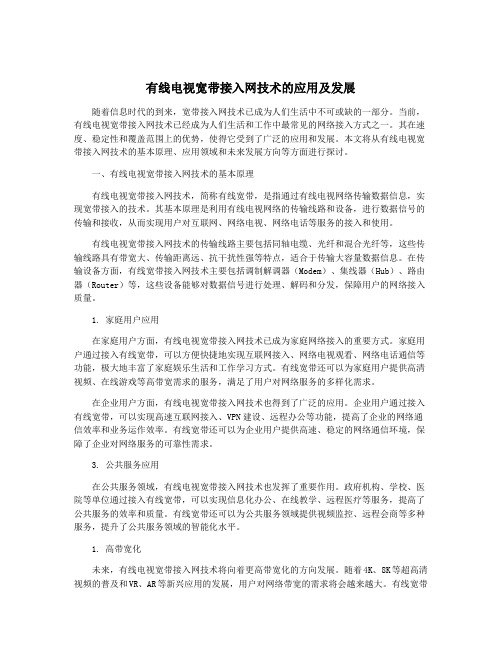
有线电视宽带接入网技术的应用及发展随着信息时代的到来,宽带接入网技术已成为人们生活中不可或缺的一部分。
当前,有线电视宽带接入网技术已经成为人们生活和工作中最常见的网络接入方式之一。
其在速度、稳定性和覆盖范围上的优势,使得它受到了广泛的应用和发展。
本文将从有线电视宽带接入网技术的基本原理、应用领域和未来发展方向等方面进行探讨。
一、有线电视宽带接入网技术的基本原理有线电视宽带接入网技术,简称有线宽带,是指通过有线电视网络传输数据信息,实现宽带接入的技术。
其基本原理是利用有线电视网络的传输线路和设备,进行数据信号的传输和接收,从而实现用户对互联网、网络电视、网络电话等服务的接入和使用。
有线电视宽带接入网技术的传输线路主要包括同轴电缆、光纤和混合光纤等,这些传输线路具有带宽大、传输距离远、抗干扰性强等特点,适合于传输大容量数据信息。
在传输设备方面,有线宽带接入网技术主要包括调制解调器(Modem)、集线器(Hub)、路由器(Router)等,这些设备能够对数据信号进行处理、解码和分发,保障用户的网络接入质量。
1. 家庭用户应用在家庭用户方面,有线电视宽带接入网技术已成为家庭网络接入的重要方式。
家庭用户通过接入有线宽带,可以方便快捷地实现互联网接入、网络电视观看、网络电话通信等功能,极大地丰富了家庭娱乐生活和工作学习方式。
有线宽带还可以为家庭用户提供高清视频、在线游戏等高带宽需求的服务,满足了用户对网络服务的多样化需求。
在企业用户方面,有线电视宽带接入网技术也得到了广泛的应用。
企业用户通过接入有线宽带,可以实现高速互联网接入、VPN建设、远程办公等功能,提高了企业的网络通信效率和业务运作效率。
有线宽带还可以为企业用户提供高速、稳定的网络通信环境,保障了企业对网络服务的可靠性需求。
3. 公共服务应用在公共服务领域,有线电视宽带接入网技术也发挥了重要作用。
政府机构、学校、医院等单位通过接入有线宽带,可以实现信息化办公、在线教学、远程医疗等服务,提高了公共服务的效率和质量。
- 1、下载文档前请自行甄别文档内容的完整性,平台不提供额外的编辑、内容补充、找答案等附加服务。
- 2、"仅部分预览"的文档,不可在线预览部分如存在完整性等问题,可反馈申请退款(可完整预览的文档不适用该条件!)。
- 3、如文档侵犯您的权益,请联系客服反馈,我们会尽快为您处理(人工客服工作时间:9:00-18:30)。
接入网的发展趋势1、接入技术的发展现状电信网发展到今天,正在进入一个新的转折点,展现了宽带化、IP化以及业务融合化的趋势。
电信网宽带化首当其冲的就是接入网的宽带化,然而由于种种原因,接入网的宽带化将是电信网宽带化最难实现的部分。
接入网可由三个接口界定,即网络侧经由SNI与业务节点相连,用户侧由UNI 与用户相连,管理方面则经Q接口与电信管理网(TMN)相连。
接入网的引入给通信网带来新的变革,使整个通信网络结构发生了根本的变化。
接入网的重要特征可以归纳为如下几点:(1)接入网对于所接入的业务提供承载能力,实现业务的透明传送。
(2)接入网对用户信令是透明的,除了一些用户信令格式转换外,信令和业务处理的功能依然在业务节点中。
(3)接入网的引入不应限制现有的各种接入类型和业务,接入网应通过有限的标准化的接口与业务节点相连。
(4)接入网有独立于业务节点的网络管理系统,该系统通过标准化的接口连接TMN,TMN实施对接入网的操作、维护和管理。
传统的用户接入同采用的是钢缆,80年代中后期因具有Z接口的光纤环路载波系统(SLC)以及远端交换模RSU的实用化,使光纤传输设备引入到接入网领域,但这些都不是真正意义上的接入网设备。
到90年代中期,先进的VS接口光接入系统问世,才进入接入网的正式发展阶段。
VS接口可实现不同厂家接入网设备与交换机的互通,接入网具有较强的业务支持能力,除支持PSTN、ISDN业务外,还支持N X 64kb/S、64kb/S以下各类速率、Internet、X.25、CATV等业务。
到1998年8月初,全国建设规模已近270万线,超过世界其它国家。
此外电信部门还积极推进公众多媒体通信接入系统,并正在试验先进的ATM接入和VOD系统。
1.1有线接入技术有线接入技术包括:基于双绞线的ADSL技术、基于HFC网(光纤和同轴电缆混合网)的Cable Modem技术、基于五类线的以太网接入技术以及光纤接入技术。
(1)基于双绞线的ADSL技术非对称数字用户线系统(ADSL)是充分利用现有电话网络的双绞线资源,实现高速、高带宽的数据接入的一种技术。
ADSL是DSL的一种非对称版本,它采用FDM (频分复用)技术和DMT调制技术,在保证不影响正常电话使用的前提下,利用原有的电话双绞线进行高速数据传输。
(2)基于HFC网的Cable Modem技术基于HFC网(光纤和同轴电缆混合网)的Cable Modem技术是宽带接入技术中最先成熟和进入市场的,其巨大的带宽和相对经济性使其对有线电视网络公司和新成立的电信公司很具吸引力。
Cable Modem的通信和普通Modem一样,是数据信号在模拟信道上交互传输的过程,但也存在差异,普通Modem的传输介质在用户与访问服务器之间是独立的,即用户独享传输介质,而Cable Modem的传输介质是HFC网,将数据信号调制到某个传输带宽与有线电视信号共享介质;另外,Cable Modem的结构较普通Modem 复杂,它由调制解调器、调谐器、加/解密模块、桥接器、网络接口卡、以太网集线器等组成,它无须拨号上网,不占用电话线,可提供随时在线连接的全天候服务。
(3)基于五类线的以太网接入技术从二十世纪八十年代开始以太网就成为最普遍采用的网络技术,根据IDC的统计,以太网的端口数约为所有网络端口数的85%。
1998年以太网卡的销售是4800万端口,而令牌网、FDDI网和ATM等网卡的销售量总共才是500万端口,只是整个销售量的10%。
而以太网的这种优势仍然有继续保持下去的势头。
传统以太网技术不属于接入网范畴,而属于用户驻地网(CPN)领域。
然而其应用领域却正在向包括接入网在内的其它公用网领域扩展。
历史上,对于企事业用户,以太网技术一直是最流行的方法,利用以太网作为接入手段的主要原因是:(1)以太网已有巨大的网络基础和长期的经验知识;(2)目前所有流行的操作系统和应用都与以太网兼容;(3)性能价格比好、可扩展性强、容易安装开通以及可靠性高;(4)以太网接入方式与IP网很适应,同时以太网技术已有重大突破,容量分为10/100/1000Mb/s三级,可按需升级,10Gb/s以太网系统也即将问世。
1.2无线接入技术传统的窄带无线接入是速率小于2Mbit/s的接入,可以提供话音和低速数据业务,上端一般连接PSTN交换机。
在众多窄带无线接入技术中,空中接口采用PHS 制式的无线市话系统得到的应用最多,规模也最大。
从2003年开始,SCDMA制式的无线接入应用也呈上升趋势,特别是在我国广大农村电信服务中被广泛推荐使用。
与传统的仅提供窄带话音业务的无线接入技术不同,宽带无线接入技术(BWA)源于Internet的发展和对宽带IP数据业务的不断增长,主要面向的是IP数据业务。
宽带无线接入方式的主流技术除包括已经发展成熟的3.5GHz、5.8GHz固定无线接入和本地多点分配系统(LMDS)等传统的固定宽带无线接入技术外,也包括新兴的IEEE802.16固定/移动宽带无线接入技术。
随着宽带技术的发展,宽带无线接入系统的传输能力在不断增强,空中接口也更加开放,被逐步成为缺乏本地网资源的新兴运营商争夺市场份额的有效手段。
在固定宽带无线接入网中,3.5GHz的固定无线接入网络在全球部署得最多。
由于其工作频段低,传播特性好,覆盖范围大,受到了运营商们的普遍青睐。
而LMDS尽管工作频率较高(26GHz),可用的频率较多,带宽也宽,但由于要求视距传播且高频段无线传输容易受降雨的影响,限制了传输的距离,同时,在网络规划时对基站和远端站的选址要求也比较高等等,因此对它的应用远不如3.5GHz固定无线接入网广泛。
对于5.8GHz频段,实际上大量使用的依然是点对点的扩频微波设备,用以解决2M传输的问题。
但由于该频段有很多非通信设备在使用,如雷达、无线电定位设备等等,存在着潜在的干扰,因此对5.8GHz固定无线接入设备的应用也不够广泛。
目前被广泛关注并被逐步应用的是IEEE提出的802.16技术。
这是一种新兴的宽带无线接入技术,主要用于城域网,有固定、游牧、便携、简单移动和自由移动五类业务应用场景。
随着802.16技术从固定无线接入发展到移动无线接入,其应用的场景也会从固定接入发展到自由移动。
802.16技术具有较高的频谱利用率和传输速率,非常适合提供宽带上网和移动视频业务[1],因此很有优势。
无线局域网(WLAN)也是一种被广泛关注和应用的无线接入技术,是在有线局域网技术的基础上发展起来的,亦属于局域网技术。
该技术改变了人们利用有线接入Internet的模式,摆脱了线缆的束缚,工作在2.4GHz免许可频段和5GHz频段。
由于免许可频段受到功率以及局域网本身定位的限制,因而WLAN主要在室内近距离使用,覆盖范围一般在100m以内,面向个人用户,为低速移动用户提供IP数据业务。
2、宽带接入网的主要功能——和窄带接入网相同,宽带接入网是连接至用户住宅的经营者业务节点的全部设施。
和窄带接入网不同的是,窄带业务网与基础网联系十分紧密,基础网与业务网统一考虑规划建设,主要业务节点与网络节点经常重合,接入网只承担接口和传输功能。
考虑到宽带接入网应支持电路模式和分组模式的接入,宽带网络的业务节点与低层的网络基础设施完全脱离,上层与下层完全是主从关系,有清晰的分层结构。
——根据宽带网络的业务节点与低层的网络基础设施完全脱离的情况,宽带网的业务节点不一定设在本地,甚至可能不在本国。
考虑到ITU-T Y.1231建议(草案),仍沿用窄带接入网的定义,将业务节点接口到用户网络接口间的全部设施定义为接入网。
宽带接入有可能需要建立跨越洋区连接。
为了避免上述现象的发生,从实际考虑宽带接入网应限定在用户驻地网,到所连接的网络的网络节点之间的设施,网络节点可能是高端路由器或ATM交换机。
宽带接入网的SNI应具有接入到多个网络节点的功能。
——宽带接入网的基本功能除保留窄带接入网的全部功能外,还应包括:——(1)将来自用户的业务流传输、寻径和多路复用至核心网;——(2)依据服务质量QoS将来自用户的业务流分类。
区别带宽有保证和尽力而为的业务流;——(3)执行服务质量QoS;——(4)提供导航帮助和目录服务;——(5)内容提供者的缓冲服务器;——(6)执行MAC协议;——(7)用户认证;——(8)提供用于调用的管理。
3、接入网的宽带化趋势近年来,固网运营商来自话音、纯宽带业务收入的增幅在不断下降,不能适应竞争和需求的变化,因此,需要从纯数据、话音的单业务运营模式向应用、视频、语音、数据相结合的多业务运营模式迈进,以留住和吸引更多的用户。
为了顺应业务发展的这一要求,未来接入技术的宽带化、接入承载的差异化和接入终端设备的可控化,将成为新一代宽带接入网的发展趋势和重要特征。
3.1接入技术宽带化“宽带提速”是运营商必然的战略选择,不提速就无法开展频带更宽的业务,无法实现运营商战略目标的转移。
因此,“宽带提速”将成为运营商长期面临的课题。
例如从ADSL向ADSL2+以及未来VDSL2的升级,就是其中的一部分。
而在这部分的解决方案中,无论采用哪种最新的DSL技术,都必须遵循缩短铜缆长度和提供更大的带宽的基本规律。
为此,全球的主流运营商包括中国的固网运营商在内,都在计划或开始实施DSLAM物理位置下移的战略,努力做到“光进铜退”,最终实现FTTH。
在这一进程中,FTTx与ADSL2+/VDSL2的结合将是长期和重要的工作内容。
3.2接入网宽带化的三个发展方向3.2.1光纤接入光纤接入,尤其同有线电视结合,高速率、低成本特性且发展潜力巨大,资源丰富。
光纤接入采用DWDM光波分复用技术,可把高达80个不同波长或数据信道复用在一个光束上,然后在一条光纤上传输。
在一个每条信道传输2.5Gbps的系统,一条光纤每秒钟可传输200Gbps的信息。
因此光纤接入网将是未来接入网的主流技术。
有源光接入设备。
目前应用的有源光纤接入设备,实现了光纤到路边或到大楼,用光纤替代了部分电缆,开通了大量的窄带数据业务,满足了社会各界对综合业务的需求,为接入网宽带化打下基础,但应用中存在如下问题:(1)有源光节点收容500~1000户的普通电话用户,将光节点建成了变相的交换机模块局,光节点以下普遍应用了较长的音频电缆,这些电缆难以适应定带业务。
(2)由于广电和电信两部门利益关系,有线电视及视频业务无法传送。
(3)大部分光节点采用小机房,配备了齐全的空调、机架、电源等辅助设备,增加了工程投资,使每线造价大大提高(高达2000元以上),在网络宽带化进程中,前期投入相当部分较难发挥作用。
计算机局域网技术应用。
为适应住宅小区宽带信息化小区建设,在光纤到楼的基础上采用计算机局域网接人用户的方式(FTTB+LAN),利用光纤+5类线以太网交换技术,实现“千兆到小区、百兆到大楼、十兆到家庭”,该宽带建设方案主要解决用户拔号上网速度太低的问题,可提供IP技术形成的多媒体业务,这种方案主要特征:在住宅小区建立千兆以太网交换机(ZAN设备),覆盖范围为以500m为半径的小区5~15幢多层住宅楼,200~500户。
